


Gouda: The place where I was born.
![]()
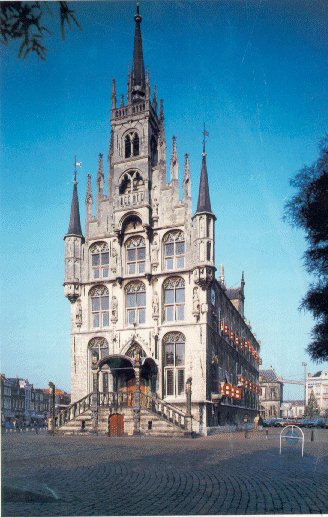 Around 1440 three faces were started to drain the ground where the new townhall was
to be build. When buying the ground, a clause was included that the townhall to be
build should remain free of any physical contacts with other buildings.
Around 1440 three faces were started to drain the ground where the new townhall was
to be build. When buying the ground, a clause was included that the townhall to be
build should remain free of any physical contacts with other buildings.
This has proven to be a wise decision, as the Sint-Jans Cathedral close by has had
fire damages many times in the past centuries.
Construction of the townhall was started in 1448. The last part, the tower, was completed in 1459. By that time, the townhall was already being used partly.
Part of that contract was also that a meat hall was to be build beneath the townhall. This was to enable an easy quality inspection of the meat by people of the city government. Currently this hall has another function and is called the "burgerhal".
In 1514 this meat hall was in an urgent need of repair. The new hall was made a bit higher, which had an impact on the parts of the townhall just above it. By the end of the 17th century, the complete building was renovated. The original gothic style was changed into a renaissance style. With the latest restoration from 1947-1953 most of the building was returned into its original gothic style.
The outside of the building is very much worth looking at, because of its many decorations. But the same is true for the inside with its magnificent white marble carvings, it's coloured glass windows and its tapestry.
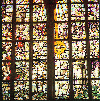 The coloured glass windows, which were manufactured in the second half of the
sixteenth century, are the most important attractions of the church. They are
commonly known as the "Goudse Glazen".
The coloured glass windows, which were manufactured in the second half of the
sixteenth century, are the most important attractions of the church. They are
commonly known as the "Goudse Glazen".
These windows were placed after the big fire in 1552. They were gifts from several
sponsors. The first sponsor was Joris van Egmond, bishop from Utrecht, who ordered the
first Glass in 1555 to be made by Dirck Crabeth, a famous glasspainter in Gouda.
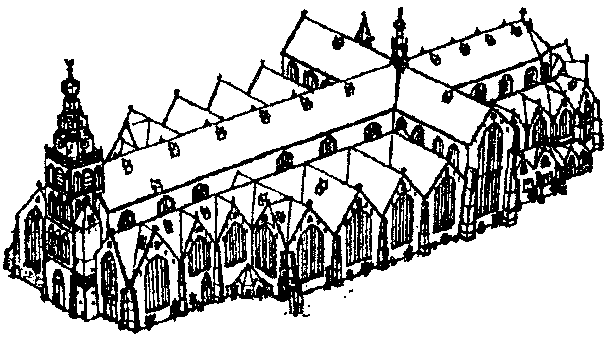 Before the Reformation, most of the sponsors were important
persons from the Roman Catholic church and nobility. After the Reformation, most
Glasses were gifts from sponsors in the country government and the governments of
the main cities.
Before the Reformation, most of the sponsors were important
persons from the Roman Catholic church and nobility. After the Reformation, most
Glasses were gifts from sponsors in the country government and the governments of
the main cities.
The first church was build in the thirteenth century and taken into service in 1278. After a big fire, which damaged most of the town, the church torn down and completely rebuild. The inauguration of this church was in 1413. Another fire damaged the church again in 1438. The restoration was used to also add four transverse chapels. The resulting five-aisle church could be inaugurated again in 1443.
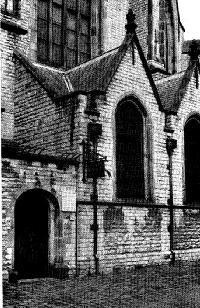 The construction of the choir was started around 1485 and completed in 1510. In 1552
the third fire was started by lightning during a thunderstorm. The next restoration
took several years. The latest important restoration was from 1964 to 1980.
The construction of the choir was started around 1485 and completed in 1510. In 1552
the third fire was started by lightning during a thunderstorm. The next restoration
took several years. The latest important restoration was from 1964 to 1980.
The Sint-Jans church is an impressive building, which dominates the old city centre because of its size. Throughout the centuries it has had an important role in Gouda.
St-Janskerk
Achter de Kerk 15
Gouda
tel. ++31-182-512684
de Waag
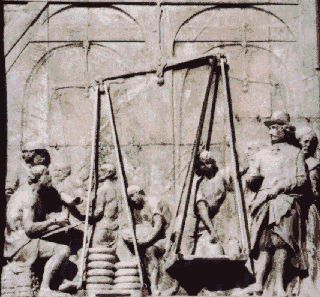 Also in the pastcenturies, weights and measures were under control of the government.
In 1490, the "Goudse keur" was declared and as result of this, all goods
over 10 pound had to be weighted in the "Waag".
Also in the pastcenturies, weights and measures were under control of the government.
In 1490, the "Goudse keur" was declared and as result of this, all goods
over 10 pound had to be weighted in the "Waag".
The Waag was not exploited by the city Gouda, but by higher authorities like the dukes of Holland, and from 1581 by the governement of Holland. Up to the beginning of the 19th century, the right to weight was leased. De first registered lease contract mentiones a sum of 16 pound. It is however not registered when the first Waag building was build.
In 1667 it was decided to build a new Waag building, because the old one had become too ramshackle. The city of Gouda was prepared to build the new Waag, provided that they would get the right for the first 15 years to lease the right weight. Pieter Post, who also designed the Mauritshuis in the Hague, received the order to design the new Waag building. It should become a monumental building. Although the building was not yet fully completed, the balances were already being used in 1670. The upper storey was being used as weaponry room for the city guards till 1907.
In due times, the right to weight became less important, thus reducing the incomes for the Waag. After 1920, the production of cheese had become the major industry. Since then, only cheese was being weighted in the Waag.
Around 1950 it was discovered that a restoration of the building was required. Between 1956 and 1958, the foundation was repaired, the walls were renewed and the interior was brought back in to its original state. The building is currently being used as museum for cheese and cheese production.
Exposeum Goudse Kaaswaag
Markt 35-36
2801 JK Gouda
telephone ++31-82-529996
fax. ++31-182-585562